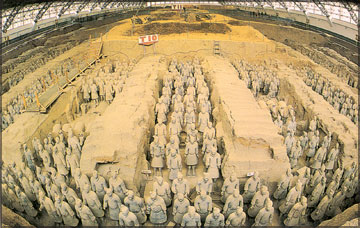
Xian - The city of terra-cotta warriors
During my recent visit to China I had the opportunity of visiting
Xian the capital of Shaanxi Province. This historical and cultural city
of China is about 15 hours of travel by train from Shanghai. Xian was
the seat of emperor Qin Shihuang who was the first to unify China.
(259-210B.c) Known as chang'an in ancient times with a history of more
than 3100 years Xian served as the capital of 11 dynasties over period
of 1100 years. His mausoleum is found at the foot of Lisyhan mountains
in Xian covering an area of 56 square kilo meters.
In addition to many places of historical interest, this city was made
world famous by the terra cotta soldiers unearthed in 1974. The story is
that a peasant by the name of Yang Shifa had found the head of a terra
cotta warrior accidentally while digging g a well. Today more than 2
million tourists visit to Xian annually. The vaults of the terra cotta
warrior and horses are found 1.5 Km east of the mausoleum of emperor Qin
Shihuang. Over 8000 pottery figures which comprised of warriors chariot
and horses were unearthed. Some cal it the 8th wonder of the world.
|

An interior Panorama of the Exhibition Hall Qin Shihuang’s
Terracotta Warriors and Horses. |
In 1987 the UNESCO inscribed the mausoleum of emperor Qin Shihuang
and the terra cotta warriors in the world heritage list.
It is believed that the emperor Qin built these warriors for his
royal guard at his next birth. From their attire and outward appearance
it is quite recognisable that some of these warriors were high ranking
officers of the kings army. The Weapons that these terra - cotta
warriors carry are free of corrosion and Chinese believe that this
phenomenon is due to a coating that was Applied on the said weapons
nearly two thousand five hundred years ago.
The building that housed the terra cotta warriors were destroyed and
burnt by an invading enemy army and was buried under earth till they
were discovered much later. The little that escaped total destruction
was salvaged by the state and subsequently rehabilitated to its original
form and preserved for posterity. Xian is one of the cities in China
that had historical ties with Sri Lanka. Now it has been confirmed that
Xian was the starting point of the silk route. According to historical
reports Chinese traders had visited Sri Lanka with their merchandise
even before the beginning of the Christian era.
The Chinese traveller monk Fahian who visited Sri Lanka in the 5th
century A.D. started his westward journey to India from his native
village Xian. The unearthing of terra cotta warriors at Xian has
transformed the lives and livelihood of the villagers of Xian
significantly. The people are more preoccupied in tourism and other
ancillary services than agriculture which was their main vocation before
the terra cotta warriors were discovered. Another noticeable factor that
stuck my attention while visiting Xian was the predominance of Muslims
living in this area.
These descendants of the Muslims traders live today as fully fledged
members of the Chinese society, speaking Chinese and following Islam.
These Muslims are famous for their culinary skills and operate fairly
large number of eating houses and lodging houses always full of Western
tourists. I was told that most tourist who visited Xian love to savor
the culinary delights of these Chinese Muslims. The kottu rotti that we
eat in Sri Lanka too are found there and the food served by them have a
strong and pleasant flavour.
In addition to terra cotta warriors there are two other important
places that a visitor to Xian should visit.
Big Wild Goose Pagoda
The Big Wild Goose Pagoda is situated in the Southern part of Xian.
The original pagoda was build in the 652 AD to house the Buddhist
scriptures brought from India by travelling monk Xuan Zang. During the
7th century this pagoda had served as a centre in the propagation of
Buddhism in China. Standing on a terrace the big Wild Goose Pagoda is an
impressive, seven story wood and brick building with total height of 64
meters. When one climbs to the top of the Pagoda it offers full view of
the ancient city, Xian.
Hua Qing Palace
Hua Qing Palace is situated in Tin Long country, 30 kms to the East
of Xian. The palace sits on the north west slopes of mount Li Shan. This
area had served as a popular site for emperors of different dynasties as
a suitable place for convalescence Due to its hot springs. The Hua Qing
Palace was built in 747 Ad or in the 6th year of Tang Tian Bao's reign.
Emperor Ming Huang of the said dynasty and the lady Yang, his favourite
concubine, used to stay here for sightseeing and bathing.
From all this one could gather that more than 2500 years ago China
was blessed with an advanced civilisation. I totally recommend that
every visitor to China should include Xian in his itinerary. Finally I
should sincerely thank the former cultural secretary of the Chinese
Embassy in Colombo madam You Shu for encouraging me to visit Xian.
R. Jinith de Silva,
Former Secretary,
Sri Lanka China Society.
--------------------------
|

